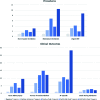High sensitivity troponin and COVID-19 outcomes
- PMID: 33685354
- PMCID: PMC7970632
- DOI: 10.1080/00015385.2021.1887586
High sensitivity troponin and COVID-19 outcomes
Abstract
Background: Recent reports have demonstrated high troponin levels in patients affected with COVID-19. In the present study, we aimed to determine the association between admission and peak troponin levels and COVID-19 outcomes.
Methods: This was an observational multi-ethnic multi-centre study in a UK cohort of 434 patients admitted and diagnosed COVID-19 positive, across six hospitals in London, UK during the second half of March 2020.
Results: Myocardial injury, defined as positive troponin during admission was observed in 288 (66.4%) patients. Age (OR: 1.68 [1.49-1.88], p < .001), hypertension (OR: 1.81 [1.10-2.99], p = .020) and moderate chronic kidney disease (OR: 9.12 [95% CI: 4.24-19.64], p < .001) independently predicted myocardial injury. After adjustment, patients with positive peak troponin were more likely to need non-invasive and mechanical ventilation (OR: 2.40 [95% CI: 1.27-4.56], p = .007, and OR: 6.81 [95% CI: 3.40-13.62], p < .001, respectively) and urgent renal replacement therapy (OR: 4.14 [95% CI: 1.34-12.78], p = .013). With regards to events, and after adjustment, positive peak troponin levels were independently associated with acute kidney injury (OR: 6.76 [95% CI: 3.40-13.47], p < .001), venous thromboembolism (OR: 11.99 [95% CI: 3.20-44.88], p < .001), development of atrial fibrillation (OR: 10.66 [95% CI: 1.33-85.32], p = .026) and death during admission (OR: 2.40 [95% CI: 1.34-4.29], p = .003). Similar associations were observed for admission troponin. In addition, median length of stay in days was shorter for patients with negative troponin levels: 8 (5-13) negative, 14 (7-23) low-positive levels and 16 (10-23) high-positive (p < .001).
Conclusions: Admission and peak troponin appear to be predictors for cardiovascular and non-cardiovascular events and outcomes in COVID-19 patients, and their utilisation may have an impact on patient management.
Keywords: COVID-19; Troponin; cardiovascular disease; outcomes.
Conflict of interest statement
The authors report no conflicts of interest.
Figures
References
Publication types
MeSH terms
Substances
LinkOut - more resources
Full Text Sources
Other Literature Sources
Medical


